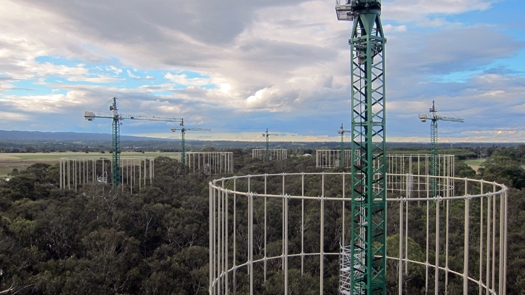A view over the forest canopy showing the cranes and partly built carbon-dioxide arrays where the experiment will take place
Regardless of whether you think human activities are causing or contributing to climate change, it’s undeniable that atmospheric carbon dioxide concentrations have increased rapidly in recent decades, and show no sign of returning to normal. How might this affect Australia’s carbon cycle in the future? Will higher concentrations of carbon dioxide in the atmosphere alter the natural stocks and flows of carbon in Australian landscapes, and if so, what will the consequences be?
A member of TERN’s Australian Supersite Network has designed and built a bold experiment to help answer these important questions. It is the Cumberland Plains EucFACE Supersite, which is the work of a DIISRTE-funded consortium hosted by the Hawkesbury Institute of the Environment at the University of Western Sydney. Site spokesperson Professor David Ellsworth said the experiment hadn’t been attempted at this scale in the southern hemisphere.
‘Essentially, it’s pretty simple. We’re going to artificially enrich carbon dioxide concentrations within a number of plots in eucalypt forest, then observe what happens to various components of the ecosystem over time,’ David says.
Photos of the experimental installation are pretty spectacular. Huge industrial cranes were brought in to construct the carbon dioxide-delivery structures, which now tower above the forest canopy. The final checks are being performed and baseline studies are establishing pre-treatment benchmarks for ecosystem characteristics, including numbers and species of plants, insects and microorganisms. The team plans to commence the experiment – turn on the gas – in September 2012.
‘We’re testing the effects of a number of elevated carbon dioxide concentrations, including some that are actually quite conservative by current projections,’ David says. ‘It’s important we run these tests because the effects on Australian ecosystems are likely to be quite different to those observed in forests in North America, for example. We need to understand a lot more about the potential of our native trees and ecosystems to sequester carbon, and their associated water requirements.’
The experiment will also enable researchers to simultaneously investigate the effects of varying water availability – drought, for example – on the trees’ capacity to store carbon.
‘Water availability is always a critical factor in Australian ecosystems, and it’s likely that climate change is only going to exacerbate that. So it’s important that we understand more about how these two drivers of ecosystem function – carbon and water – are going to interact to affect things like tree growth,’ David says.
The results of the EucFACE experiment will have a number of immediate applications. Improved understanding of the rates at which our native forests store carbon, and how this is likely to alter with increased concentrations of atmospheric carbon dioxide and with climate change, is essential information for planning and for participating in national and international carbon-trading schemes. On a more practical level, the results will help ensure that tree plantings for carbon sequestration do not substantially reduce water supplies for agricultural and domestic use.
The EucFACE experiment has already attracted significant mainstream media attention in Australia and internationally. Keep an eye on the project website for updates on progress.
Published in the TERN e-Newsletter July 2012







